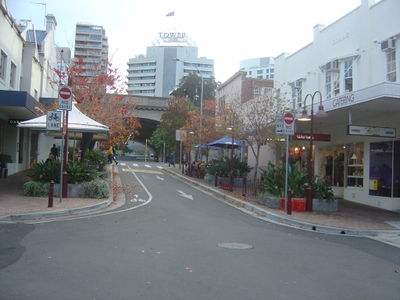Key:access: Difference between revisions
replaced hierarchy picture by an outline so it can contain descriptions and easily be modified and reverted (also tweaked designated/official descriptions) |
Added generic direction-dependent access tags |
||
| Line 60: | Line 60: | ||
=== Transport mode hierarchies === |
=== Transport mode hierarchies === |
||
The transport modes can be arranged in tree structures which tracks which modes are more specific and which are more generic. |
The transport modes can be arranged in tree structures which tracks which modes are more specific and which are more generic. |
||
| Line 99: | Line 97: | ||
* {{Tag|access}} (category: any rail-based transportation mode) |
* {{Tag|access}} (category: any rail-based transportation mode) |
||
** {{Tag|train}} (trains) |
** {{Tag|train}} (trains) |
||
| ⚫ | |||
Ways may have different access restrictions for each direction. The most simple case is a way designated as a oneway road: |
|||
| ⚫ | |||
| ⚫ | |||
* {{Tag|oneway||no}} ''default, access is allowed in both directions (this key/value combination does not need to be added to ways)'' |
|||
For more complex direction dependent restrictions, the postfixes <code>:backward</code> and <code>:forward</code> can be used on the keys, for example: |
|||
* {{Tag|bicycle:backward|no}} (when a road has a oneway cycleway next to it that must be used, and a cyclelane in the other direction) |
|||
* {{Tag|bicycle:backward|yes}} (when cyclists are allowed to travel in both directions on a oneway street (but no lane is present)) |
|||
The oneway tag can be translated (for routing purposes) to this generic system as follows (oneway restrictions presumably do not apply to pedestrians): |
|||
* {{Tag|oneway|yes}} to {{Tag|vehicle:backward|no}} |
|||
* {{Tag|oneway|-1}} to {{Tag|vehicle:forward|no}} |
|||
== Other access restrictions == |
== Other access restrictions == |
||
These are additional tags (keys & values) which can be used in conjunction with the above, to detail other kinds of access restriction. |
These are additional tags (keys & values) which can be used in conjunction with the above, to detail other kinds of access restriction. |
||
| ⚫ | |||
* {{Tag|oneway||no}} ''default'' |
|||
| ⚫ | |||
| ⚫ | |||
===Time restrictions=== |
===Time restrictions=== |
||
Revision as of 20:50, 20 August 2009
 |
| Description |
|---|
| For describing the legal accessibility of an element. |
| Group: Restrictions |
| Used on these elements |
| Documented values: 21 |
| Useful combination |
| Status: de facto |
| Tools for this tag |
|
Use access tags to describe the allowed or preferred level of access along a footpath, road, or any other kind of way element.
Values
access=unknownThe access conditions are unknown or unclear. This is the default value for most features.access=yesThe public have official, legally-enshrined right of access, i.e. it's a right of way.access=designatedThe way is a preferred/designated route for a specific vehicle type or types (by law or otherwise) but not compulsary, often marked by a traffic sign.access=officialUse of the way is restricted to specific modes of travel by law. It may also be compulsary in which case a parallel way without this designation cannot be used. Usually marked by traffic signs.access=destinationThe public has right of access only if this is the only road to your destination.access=agriculturalOnly for agricultural traffic.access=forestryOnly for forestry traffic.access=deliveryThis route may only be used to deliver goods to a customer.access=permissiveThe owner gives general permission for access.access=privateThe owner may give permission on an individual basis.access=noAccess by this transport mode is not permitted, they don't have a right of way.
Transport mode restrictions
Use the access key to describe a general access restriction (all transport modes). This may be tightened or relaxed by more specific transport modes. The following are keys which take the same set of possible values listed above (Confused? see the #Examples below)
- foot
- bicycle
- motorcycle
- moped
- horse
- vehicle (group including all vehicles, e.g. bicycle, snowmobile, motorcar)
- motor_vehicle (group including all motorised vehicles, e.g. motorcar, motorcycle, hgv.)
- motorcar
- caravan
- goods (Goods vehicles up to 3.5 tonnes)
- hgv (Heavy Goods Vehicle - usually more than 3.5 tonnes, though regulations vary from place to place.)
- psv (Public Service Vehicle - e.g. bus)
- hov (high occupancy vehicle - usually more than 2 persons)
- agricultural
- emergency
- hazmat (Hazardous Material)
- ski
- ski:nordic
- ski:alpine
- ski:telemark
- snowmobile
- motorboat
- boat
Transport mode hierarchies
The transport modes can be arranged in tree structures which tracks which modes are more specific and which are more generic.
Land based transportation
access=*(category: any land-based transportation mode)foot=*(pedestrians)horse=*(horse riders)vehicle=*(category: any vehicle)bicycle=*(cyclists)carriage=*(horse(s) + carriage)wheelchair=*(physical access for wheelchair users)motor_vehicle=*(category: any motorized vehicle)motorcycle=*(a two-wheeled motor vehicle without a (low) speed or motor power limit)moped=*(motorized bicycles with at most a 50cc engine or max speed of about 50km/h)mofa=*("low performance moped", usually with a maximum design speed of 25km/h)motorcar=*(category: motor vehicles with more than 2 wheels / more than 1 track)automobile=*(a motor vehicle for transporting a limited number of passengers - this tag is likely not needed but here for completeness)caravan=*(needs to be towed by another vehicle which has its own restrictions)goods=*(light commercial vehicles, e.g. goods vehicles with a maximum allowed mass of up to 3.5 tonnes)hgv=*(heavy goods vehicle, e.g. goods vehicles with a maximum allowed mass over 3.5 tonnes)psv=*(public service vehicle)agricultural=*(agricultural motor vehicles, e.g. tractors, that have additional restrictions, e.g. a 25km/h speed limit)emergency=*(category: emergency motor vehicles, e.g. ambulance, fire truck, police car)hazmat=*(motor vehicles carrying hazardous materials)
Not yet in the above tree: ski=*, ski:nordic=*, ski:alpine=*, ski:telemark=*, snowmobile=*, hov=*
Water based transportation
Rail based transportation
One-way restrictions
Ways may have different access restrictions for each direction. The most simple case is a way designated as a oneway road:
oneway=yesdriving is only allowed in the direction of the wayoneway=-1driving is only allowed against the direction of the wayoneway=nodefault, access is allowed in both directions (this key/value combination does not need to be added to ways)
For more complex direction dependent restrictions, the postfixes :backward and :forward can be used on the keys, for example:
bicycle:backward=no(when a road has a oneway cycleway next to it that must be used, and a cyclelane in the other direction)bicycle:backward=yes(when cyclists are allowed to travel in both directions on a oneway street (but no lane is present))
The oneway tag can be translated (for routing purposes) to this generic system as follows (oneway restrictions presumably do not apply to pedestrians):
oneway=yestovehicle:backward=nooneway=-1tovehicle:forward=no
Other access restrictions
These are additional tags (keys & values) which can be used in conjunction with the above, to detail other kinds of access restriction.
Time restrictions
- date_on
- date_off
- day_on
- day_off
- hour_on
- hour_off
Size and statutory restrictions
maxweight=*maxaxleload=*maxheight=*legal height restrictionmaxheight:physical=*physical height restriction (proposed, see Proposed_features/clearance)maxwidth=*(Also notewidth=*for the physical width of the entire road.)maxlength=*maxdraught=*maxspeed=*minspeed=*
User Defined values
Any valid syntax value except core values. Rules applying to General statutory restrictions
Examples
Transport mode restrictions
<tag k="access" v="private"/> There is no public access (unless relaxed by another tag from below) <tag k="foot" v="yes"/> The public has a right of way when travelling on foot. <tag k="bicycle" v="yes"/> The owner has given permission for bicycle access <tag k="horse" v="designated"/> The route is designated for use by equestrians. <tag k="motorcycle" v="unknown"/> It is unclear whether motorcycles can use this section <tag k="motorcar" v="private"/> Access by car is private, eg on a private road <tag k="goods" v="no"/> Closed to general goods vehicle traffic <tag k="hgv" v="no"/> Closed to heavy goods vehicle traffic <tag k="boat" v="no"/> Waterway unnavigable by boat
Routing restrictions
oneway

<tag k="oneway" v="yes"/>Indicates that the direction of travel is only in the direction in which the segment was drawn (ie from the from node to the to node). If the way is one-way in the opposite direction then a value of -1 should be used.
This street (Burton Street, North Sydney) is a one-way street with a cycle lane in the opposite direction. It can be described using the following tags:
Default: If the tag is absent, unrestricted passage in both directions should be assumed.
Access time restrictions
date_on=YYYY-MM-DDSets the start date for an access closuredate_off=YYYY-MM-DDSets the end date for an access closuredate_on=saturdayClosure each week starts at the beginning of this daydate_off=saturdayClosure each week ends at the end of this dayhour_on=HH:MM:SSClosure starts at this timehour_off=HH:MM:SSClosure ends at this time
Size and statutory restrictions
<tag k="maxweight" v="7"/> The restricted weight limit in tonnes, eg 7 t <tag k="maxaxleload" v="3.5"/> The restricted weight limit per axle in tonnes, eg 3.5 t <tag k="maxheight" v="2.5"/> The restricted headroom limit in metres, eg 2.5 m <tag k="maxwidth" v="3"/> The restricted width limit in metres, eg 2 m <tag k="maxlength" v="15"/> The restricted length limit in metres, eg 15 m <tag k="maxdraught" v="1"/> The maximum boat draught depth for navigation in metres, eg 1 m <tag k="maxspeed" v="110"/> The restricted speed limit in km/h, eg 110 km/h <tag k="minspeed" v="50"/> The minimum speed required in km/h , eg 50 km/h <tag k="maxstay" v="14 days"/> The maximum stay permitted; units in the tag as either hour/hours or day/days.
See also
- Access-Restrictions
access=designated- different explicit administrative designations (like footway, cycleway, bridleway)highway=cyclewayhighway=footwayhighway=bridleway- Approved features/More access keys and values